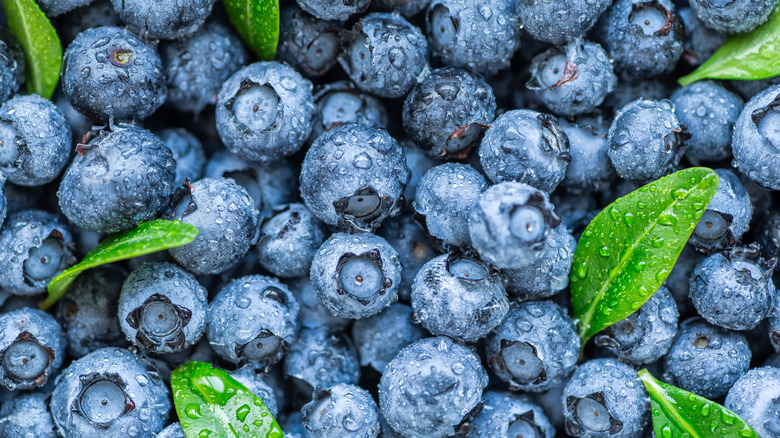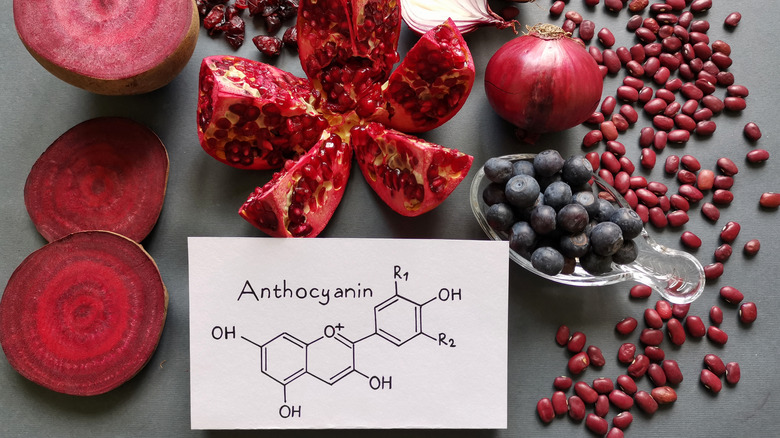The Difference Between Wild Blueberries And Farmed Blueberries
Whether you start your day with a decadent blueberry muffin or end it with a delightful blueberry-lemonade cocktail, juicy, colorful blueberries can play a role in any meal. But have you ever wondered if there's a difference between blueberries labeled "wild" and all the other blueberries you see? It turns out there is.
On the most basic level, farmed blueberries, also called highbush blueberries, are cultivated, and according to the U.S. Highbush Blueberry Council, nearly 1 billion pounds are grown in North America every year. Highbush blueberries were first produced commercially in 1916, which means we've been able to find these beautiful berries at the market for more than a century, per the USDA.
Wild blueberries, on the other hand, have grown primarily in the cold climates of Maine and Canada for more than 10,000 years, according to the Wild Blueberry Association of North America. Wild blueberries were prized by Native Americans, both as a food source and also for their medicinal properties (per the Berkeley Horticultural Nursery).
The science of blueberries
But what makes wild blueberries so different from farmed blueberries? It's all about science.
Blueberries — both wild and farmed — are nutritional superfoods, containing vitamins C and K, along with a healthy dose of manganese. While both kinds of blueberries also contain plenty of antioxidants, Boston Organics reports that a flavonoid called anthocyanin is responsible for the beautiful color of blueberries — and according to the journal Advances in Nutrition, wild blueberries contain more than 25% more anthocyanins per serving than farmed blueberries.
There are two basic reasons why. First, wild blueberries are much smaller in size than farmed blueberries. Research published in the International Journal of Food Properties demonstrates that anthocyanin is concentrated in the blueberries' skin, meaning one cup of tiny wild berries yields more berries and, therefore, more skin — and more of those wonderful antioxidants.
And second, it's the colder climate that wild blueberries are grown in that gives them an antioxidant boost; they produce these chemicals to help them survive in their environments. As Dr. Mary Ann Lila, of the Plants for Human Health Institute at North Carolina State University, explained to The New York Times, "They're not pampered like the cultivated blueberries."
Wild blueberries in the kitchen
What matters to home cooks, though, is less the science and more how wild blueberries and farmed blueberries compare in the kitchen. One of the best things about highbush blueberries is that we can enjoy them fresh all year long; when they're not being harvested in North America during winter months, supermarkets can source them from South America, per the U.S. Highbush Blueberry Council.
When it comes to flavor, though, it's hard to beat the wild blueberry. According to the Wild Blueberry Association of North America, these tiny blueberries pack more flavor, zingy acidity, and sweetness than cultivated blueberries. Dr. Stephen Pratt, M.D. explains to SuperfoodsRX that since they also contain a higher ratio of skin to flesh, a pound of wild blueberries yields more actual fruit than a pound of highbush blueberries. And more importantly for a home chef, wild blueberries perform better for baking than farmed blueberries, says Food Business News, since they hold their shape and color better in recipes like this delicious blueberry clafoutis.
Wild or farmed, blueberries add delightful color and flavor to your cooking, from savory sauces to lattice-topped pies. They are a versatile way to brighten any meal; if you haven't yet, give both varieties a try and see which one you like better.


